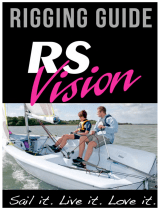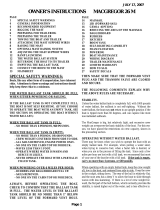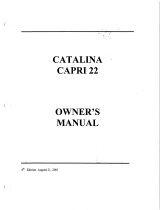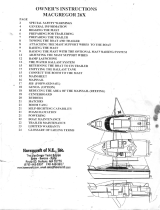Page is loading ...

31/05/01 KT/ir
635($'(55$.(
Spreader rake is the distance from the trailing edge of the mast to an imaginary line
between the tips of the spreaders. To measure spreader rake, place a straight edge
between the spreader tips and then measure the distance from the trailing edge of
the mast.
As a starting point we recommend:
½ Crew weight less than 75 kg = 70 mm or more
½ Crew weight of 75-90 kg = 50-65 mm
½ Crew weight more than 90 kg = 45 mm or less
In general, for heavier crew weight, reduce spreader rake and for lighter crew weight,
increase spreader rake.
After adjusting spreader rake, it is wise to tape up all pins, split rings and sharp
edges. Particularly if you are using an optional headsail or spinnaker.
',$021':,5(7(16,21
Diamond wire tension is best measured using a rig tension gauge – Loos gauge or
similar.
As a starting point we recommend:
½ Wind under 10 knots = 34 on gauge
½ Wind 10 – 20 knots = 36 – 39 on gauge
½ Wind over 20 knots = 40 or over on gauge
If a tension gauge is not available simply tension the turnbuckle until the fork is in the
centre of the shield plate.
TUNING GUIDE
$
GMXVWHU6FUHZ
6SUHDGHU5DNH
6WUDLJKW(GJH

31/05/01 KT/ir
In general:
½ For light winds or heavy crew weight = reduce tension
½ For strong winds or lighter crew weight = increase tension
0$675$.(
Adjust mast rake to suit wind conditions and crew weight as follows:
½ Increase rake for stronger winds or lighter crew weight
½ Reduce rake for lighter winds or heavier crew weight.
There are several factors that determine the most suitable mast rake.
Crew weight, wind strength and sea conditions. A good starting point is
to position the sidestays in the centre hole of the stay adjuster and
tension the forestays to suit. Adjust then if necessary as per the guide
or personal preference.
0$67527$7,21
A good starting point is to have the rotation arm pointing towards the sidestay for
sailing to windward. To depower, decrease mast rotation or point the rotation arm
more towards the back of the boat.
To get more power, increase the amount of mast rotation or point the rotation arm in
front of the sidestay.
For downwind sailing increase the amount of mast rotation.
58''(5%/$'($/,*10(17
A good starting point is to have the rudder blades slightly toed-in. 3-5 mm is
recommended. This means that the distance between the two rudder blades leading
edges is 3-5 mm less than the distance between the trailing edges.
Use the threaded adjuster cap on the tiller crossbar to adjust alignment.
+$9($+2%,('$<
/





